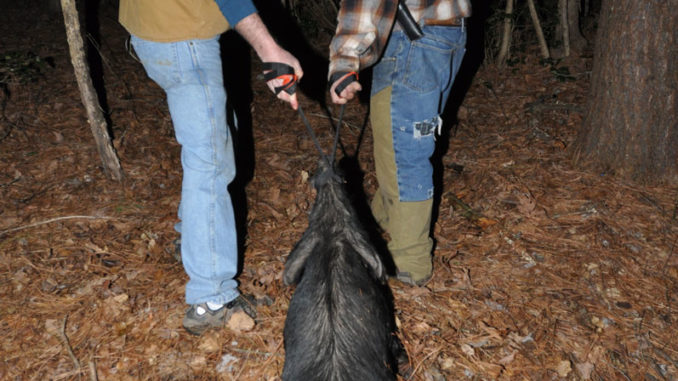
There’s nothing like a pile of vegetables to put wild hogs in range of a waiting hunter.
Many hunters feel as though they’ve lost their best friends during the downtime between the end of deer and bear season and the beginning of spring turkey season. However, those who want to continue to experience the thrill that only seeing a large animal brings are increasingly turning to feral hogs.
Johnnie Dale operates Buffalo Creek Hunting Lodge and Guide Service; he guides hunters for many species, but at his Delway Lodge in Sampson County, hogs are always on the menu.
“Hogs can be added to any hunt for deer, turkeys or other game,” Dale said, “but some hunters come just to hunt hogs, with January through early April some of our best months. Hogs are hungry and move around a lot when the weather is cool.”
Dale’s hunter one day last winter was Keith Brady, a retired magistrate from Burlington who hunts plenty of different species but hunts hogs more than any other game.
“I hunt rabbits and deer but really like hunting hogs,” Brady said. “I started hunting them with some friends about 20 years ago at a guiding operation in South Carolina. It is something to do after deer season goes out, but it is more challenging than hunting deer. Now that you can hunt them in the dark, it gives you a better chance of taking a big boar.”
Brady’s biggest pig is a jet-black, 300-pound boar taken about six years ago. He said the advantage of hunting a black hog is that it is more visible than a hog of a lighter color in the dark. He shoots a Savage bolt-action rifle chambered for .243.
A .243 is the lightest caliber I recommend,” Dale said. “Anything smaller is not reliable enough. The best place to shoot a hog, unless you want to keep the head for a mount, is at the bottom corner of the ear. It will drop him right there and doesn’t ruin any meat.”
Dale’s Delway operation has 3,500 acres along Black River and Six Runs Creek. The flood plain’s bogs, swamps and oxbows are prime cover for hogs, so he has to lure them out into the open. To keep hog hunters happy, he maintains 130 elevated stands overlooking piles of bait and automatic feeders. He also uses a mineral supplement called Trophy Rock to attract hogs and enable them to grow fat and sleek.
“I use tripod, hand-built and hanging stands,” he said. “The hanging stands are the best because they are the least visible. We don’t have any bears in this area, so they aren’t eating the bait we set out for pigs or damaging our feeders. We took more than 300 hogs over 150 hunter-days last year, and most of them weighed around 100 pounds. The biggest one weighed 515 pounds, and we have a photo of one on a game camera that weighs more than 750 pounds that nobody has seen.
“We have to kill 70 percent of the hogs each year just to maintain the herd at a constant number, but we don’t want to overharvest them. We have to strike a balance between growing crops and having hogs to hunt, which is the same situation as with growing crops and having deer.”
Dale manages his crops and hunting areas with electric fencing. He has more than 500 acres enclosed with electric fences and uses different wire placements. Some of his electric fences allow hogs to pass through and deer to jump over while keeping out straying pets and feral dogs. He has other fences that prevent the majority of hogs from eating his agricultural crops, which include corn, soybeans, wheat and sweet potatoes. However, no electric fence keeps every hog out of a field.
After helping into his stand, Dale eased his ATV along, stopping here and there to open a gate or check for hog tracks and other sign. At one place, he saw several sows with piglets, comprising a sounder of about two-dozen hogs. When they saw the 4-wheeler, they ran into thick cover.
“Hogs move around a lot,” he said. “They might be in one area for several days in a row, and then suddenly move a long way to another area. Fresh sign like wallows, tracks, droppings and rooted areas are the best way to tell where they are likely to come out of the swamp. Game cameras can help by telling you the time of day or night they are moving.”
To ensure hogs come out into the open, Dale spends thousands of dollars buying produce each year. He also grows at least 20 acres of sweet potatoes to add to the bait piles and sets up broadcast feeders filled with corn. Another tactic is a dedicated trapping program. He takes bobcats, raccoons, foxes, coyotes and other predators to keep them from eating too many piglets.
Tommy Sullivan of Leland, who guides for Dale at Delway, has been hunting hogs for about three years.
“I first started hunting hogs as a way of extending my passion for bear hunting,” Sullivan said. “My first hog hunt was at night. Six hunters sat in ground blinds from an hour after dark until 2 a.m., and we didn’t see a thing. At that point, I was done with pig hunting. But, then my dad booked a trip with Johnnie, and we had such great success that he can’t get rid of me.”
Sullivan shoots hogs with a Remington 760 pump-action in .270. He aims right behind the shoulder.
“If you hit him right, he will stop right there,” he said. “I don’t want to track one. If you wound him, he is going to find the worst place he can and wait for you to come in, crawling on hands and knees along on his trail. If he is still alive when you find him, you might not be so happy that you did.”
Dale has a blood-trailing hog dog named Jake, a beagle who brings to mind the saying, “It’s not the size of the dog in the fight, it’s the size of the fight in the dog.”
“I had a wounded hog run over top of me,” Dale said. “I was tracking him with Jake when the dog ran between my legs and the hog came right behind, chasing Jake. Jake bayed the hog three more times before we got him.”
Dale said most wounded hogs run about 100 yards before the dog brings them to bay. He has had hogs bay as many as seven times before he was finally able to kill them.
DESTINATION INFORMATION
HOW TO GET THERE — From Raleigh, take I-40 east to Exit 343 and turn south on US 701 for 2.7 miles to US 421, then take US 421 11.3 miles to River Road, where you turn left and drive the final 2.2 miles to Buffalo Creek Hunting Lodge.
WHEN TO GO — Feral pigs are legal to hunt year-round, even at night. They offer an excellent opportunity for big game hunting in January, February and March, between deer and wild turkey seasons.
EQUIPMENT — Any centerfire rifle in .243 or larger will work for hunting hogs. The best places to aim are the lower corner of the base of the ear or immediately behind the shoulder. Hunters typically sit in elevated stands overlooking bait piles.
FISHING INFO/GUIDES — Johnnie Dale, Buffalo Creek Hunting Lodge and Guide Service, 800-868-6265 or 919-915-0193, www.buffalocreekguideservice.com. See also Guides and Charters in Classifieds.
ACCOMMODATIONS — The Delway Lodge, Magnolia, 910-532-2380.
MAPS — DeLorme North Carolina Atlas and Gazetteer, 800-452-5931 or www.delorme.com.

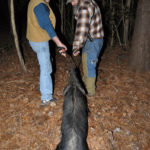
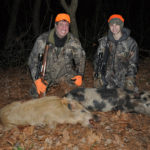
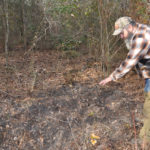
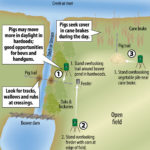



Be the first to comment